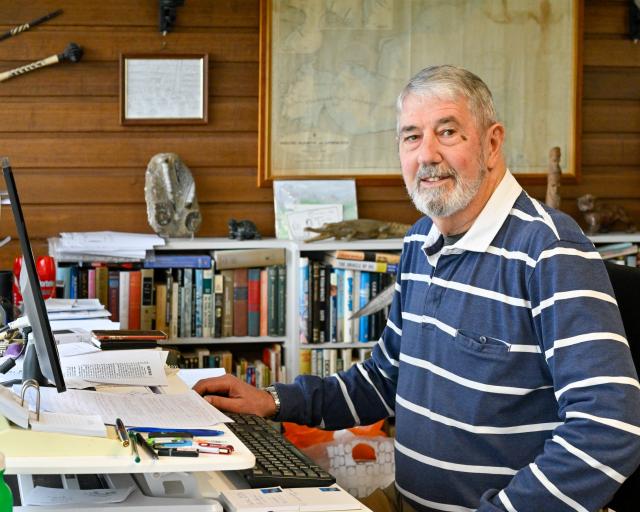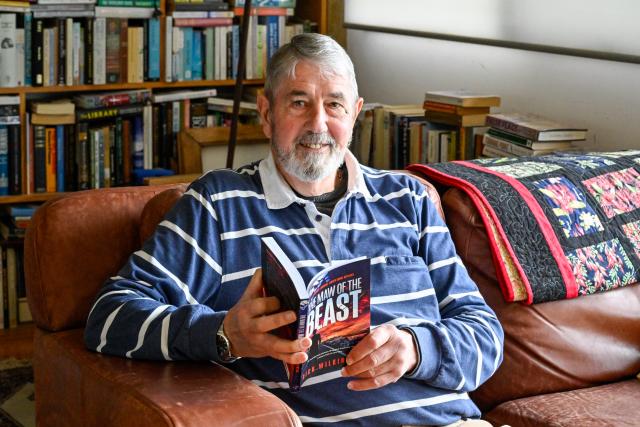Portarlington author and journalist Rick Wilkinson launched his new novel The Maw of the Beast last week. Matt Hewson caught up with him to discuss his journey from geology to crime fiction.
From his earliest days as a schoolboy at Caulfield Grammar, Rick Wilkinson knew he wanted to be a writer.
“I’ve been writing stories, fiction, since I was about 12 years old, and literature was always my favourite at school,” Rick said.
“That’s all I knew, that’s what I really wanted to do. But there were no real jobs; arts was a bit nebulous in those days, there was nothing you could do with it unless you wanted to teach.”
Born in 1947, Rick grew up in the suburbs of St Kilda, Balaclava and Ripponlea, the son of an airline manager father and hairdresser mother.
There were plenty of books in the Wilkinson house; Rick’s father loved Dickens and the classics and his mother would read to him and his younger sister before bedtime.
In particular, Rick was drawn to classic Australian children’s books exploring the natural world of our continent, such as Blinky Bill and Snugglepot and Cuddlepie.
“I like nature, I always have, and stories around animals and things like that,” Rick said.
“I just love to be outdoors. I was outdoors all the time, we went on excursions as a family on the weekends.
“By the time I got to the stage of choosing (a career), I started looking around for something where I could be outdoors. I didn’t want to be confined to an office; I wanted something to do with my hands, get around and see things.”
Rick decided to pursue a career in geology, but by his own admission, he didn’t have a particular bent for mathematics.
So he began his studies at RMIT, which offered bridging mathematics subjects, then completed his degree at the University of Western Australia (UWA).
“It was great, it was away from home… I was one of those kids that could hardly wait to leave,” Rick said.
“And of course, part of the course was work experience, so I worked down mines, went to New Guinea, got around the Pilbara. That’s what I wanted to do, and I enjoyed it.”
For two years after receiving his degree from UWA, Rick worked in Cloncurry, Queensland for Mount Isa Mines offshoot Carpentaria Exploration.
“They were mostly in for copper – it was an exploration company – so I was out in the bush looking for and bashing rocks in the hot sun, basically,” he said.
“But even then, I’d got to 22 and I still wanted to write. And I’d done a couple of things for their magazine and they said oh yeah, not bad.
“So I said, right, I’m going. And London was the thing to do in those days.”
In 1972 Rick, now married, bought himself and his wife Aileen a return ticket to England to pursue his dreams of being a journalist.
Upon arrival he went straight to Fleet Street, the home of London’s newspaper industry, but was just as quickly rebuffed.
However, Rick got the tip that a new magazine focused on the burgeoning North Sea oil industry was about to start up, and with his credentials as a geologist he applied immediately.
“I became the exploration editor of the Oil Man; talk about luck, it was about three days after I actually got to London,” he said.
“That was 50 years ago, and I’ve been writing ever since.”
Over the next decade, Rick’s professional life blossomed. He established himself as an in-demand oil and energy journalist in the UK, writing for a number of publications.
His personal life through this period had its ups and downs; he and his wife, now with a daughter, divorced and Rick married an English doctor, Sharron.
In 1979 Rick and Sharron moved back to Australia, where he picked up a job at the Australian, the last he ever applied for.
“I worked there for a couple of years, and since then someone just says, would you like to…?” he said.
Rick wrote for the Financial Review, Australian Business and the Australian Institute of Petroleum’s monthly magazine, among others. It was during this time that he began writing both non-fiction and children’s books.
“When I got back here in the 80s I didn’t know a lot about the petroleum industry in Australia, its background,” he said.
“So I thought, well, I’m looking into it, I might as well write a story about it. I found it fascinating, because petroleum characters are marvellous, going right back to John Lort Stokes and the (HMAS) Beagle.
“Then I got a couple of commissions to write company histories, and then the history of the Bureau of Mineral Resources (now Geoscience Australia).”
At the same time, inspired by his daughter Susie, Rick began writing children’s stories in the early morning before starting work at the Financial Review.
Rick’s first two children’s books were picked up by Allen & Unwin, and he continued to write about animals and nature for kids.
After Sharron’s death in the mid-90s Rick made another snap decision, this time moving to Portarlington.
“It was another one of those lucky things in my life that just happened,” Rick said.
“This (house) was only on the market for three days, and the bloke wasn’t here when I wanted to see it.
“But the block was vacant next door so I walked around and had a look at the house from the back and I thought, I’ll take this.
“I hadn’t even seen it. It was just one of those things, you know, and that was 26 years ago.”
Since then Rick has written all sorts of things; travelogues, histories, more kids books and recently two novels.
Last year Rick released the Invaders, an expansive tale set across three different time periods across Australia and the work he considers “one of the most pleasing things” he’s written.
The Invaders incorporates Rick’s knowledge of Australia’s burgeoning oil industry in the mid-1800s, as well as a fictionalised account of little-known army recon outfit the Nackeroos, who roamed Australia’s top end during WWII.
Last week Rick released the first novel in a series of crime yarns focused on protagonist George “Jogger” Jensen, a “disillusioned crime reporter” who returns to his childhood town of Portarlington.
With no police background himself, Rick chose to make his investigator a journalist – “You’ve got to write what you know” – and drew on his partner Elaine, who introduced him to the crime genre, as a sounding board.
Rick has woven historical aspects of the Bellarine into his latest book, not so much as plot elements, but more to paint a rich and sometimes edifying backdrop for the mystery that unfolds.
“It’s something I was interested in, so I tried and put bits and pieces of that in writing, not to be a teaching manual, but just to drop them in so people are learning stuff about the area as well as hopefully being entertained,” he said.
“Whether anyone who’s not from this area is going to be interested, I don’t know. That’ll be the test.”
Rick is currently working on further “Jogger” Jensen novels, as well as a history of the Portarlington Football Club, which turns 150 next year.
“The Bellarine is a fun place; it’s the best decision I ever made, to come here,” he said.
“I’ll be here, writing on. I’ll probably just keep going till I can’t.”








